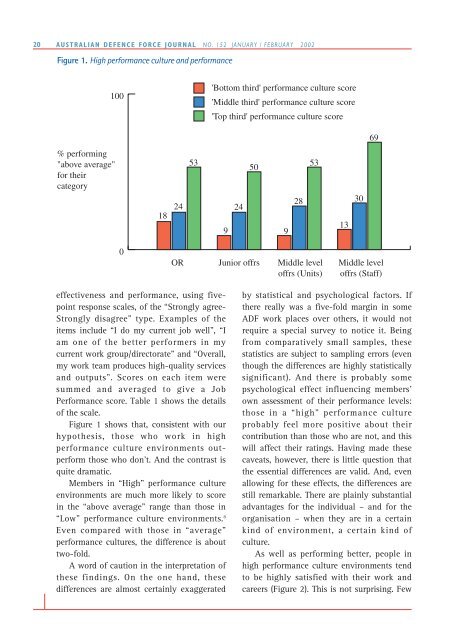ISSUE 152 : Jan/Feb - 2002 - Australian Defence Force Journal
ISSUE 152 : Jan/Feb - 2002 - Australian Defence Force Journal
ISSUE 152 : Jan/Feb - 2002 - Australian Defence Force Journal
- No tags were found...
You also want an ePaper? Increase the reach of your titles
YUMPU automatically turns print PDFs into web optimized ePapers that Google loves.
20AUSTRALIAN DEFENCE FORCE JOURNAL NO. <strong>152</strong> JANUARY / FEBRUARY <strong>2002</strong>Figure 1. High performance culture and performance100'Bottom third' performance culture score'Middle third' performance culture score'Top third' performance culture score69% performing"above average"for theircategory182453924509285313300OR Junior offrs Middle leveloffrs (Units)Middle leveloffrs (Staff)effectiveness and performance, using fivepointresponse scales, of the “Strongly agree-Strongly disagree” type. Examples of theitems include “I do my current job well”, “Iam one of the better performers in mycurrent work group/directorate” and “Overall,my work team produces high-quality servicesand outputs”. Scores on each item weresummed and averaged to give a JobPerformance score. Table 1 shows the detailsof the scale.Figure 1 shows that, consistent with ourhypothesis, those who work in highperformance culture environments outperformthose who don’t. And the contrast isquite dramatic.Members in “High” performance cultureenvironments are much more likely to scorein the “above average” range than those in“Low” performance culture environments. 8Even compared with those in “average”performance cultures, the difference is abouttwo-fold.A word of caution in the interpretation ofthese findings. On the one hand, thesedifferences are almost certainly exaggeratedby statistical and psychological factors. Ifthere really was a five-fold margin in someADF work places over others, it would notrequire a special survey to notice it. Beingfrom comparatively small samples, thesestatistics are subject to sampling errors (eventhough the differences are highly statisticallysignificant). And there is probably somepsychological effect influencing members’own assessment of their performance levels:those in a “high” performance cultureprobably feel more positive about theircontribution than those who are not, and thiswill affect their ratings. Having made thesecaveats, however, there is little question thatthe essential differences are valid. And, evenallowing for these effects, the differences arestill remarkable. There are plainly substantialadvantages for the individual – and for theorganisation – when they are in a certainkind of environment, a certain kind ofculture.As well as performing better, people inhigh performance culture environments tendto be highly satisfied with their work andcareers (Figure 2). This is not surprising. Few
















